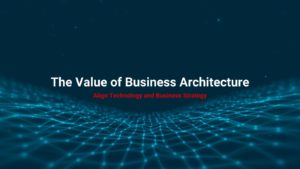This is the continuation of the fourth part of an ongoing series, where I’m using the framework of WHY, WHAT, HOW, WHO from my book Blind Spot: A Leader’s Guide To IT-Enabled Business Transformation – enhanced with stories and analogies – to help business leaders to understand the Digital and IT transformation journey in very simple business terms.
The crisis of the last few months should have clarified WHY we need to change, and that the time is NOW (Part 1). Only a few senior leaders are still wondering about or resisting that premise. One real challenge, for the entire executive team, is to think about WHAT will make us faster and more flexible, which is “Business Agility” (Part 2). Of equal importance this time, as I wrote in Part 3 and Part 4 of this series, HOW we architect and build modern systems matters – a lot – because we can’t have Business Agility if we keep adding to our Technical Rigidity. And, in order to build it right and see the Business Agility value come to fruition, we have to finance and manage our IT investments the right way.
Before writing this blog post, I reached out to a former colleague, Mike White, who was the CFO at Frito-Lay while I was there in the 1990s. I wanted his thoughts about this important topic. Mike went on to become the CEO of PepsiCo International and then became the Chairman and CEO of DirecTV prior to their sale to AT&T. He is a good friend and colleague who put a lot of energy and encouragement into this topic of rethinking how IT investments need to be thought of going forward.
Part 6: HOW Do We Get The Value For Our Investments?
To change the game, we’ve got to change the dialogue and our basic assumption that IT is simply “overhead”. I believe that most executive committees and CFOs believe that technology is now and will forever be pervasive. Most know that IT is no longer just a “function” as much as it is a “fabric” that enables other functions’ productivity and, as importantly, connects functions, business units, customers, suppliers, and employees in an ecosystem. That “fabric” and WHAT IT enables – cross-connections as well as real-time and strategic sense-and-respond agility – is the productivity force multiplier that is the essence of the Digital Era.
The question is not whether or not we should change the IT investment mechanism. The question is what we should change it to – and still maintain the accountability, control, and the ability to create measurable value.
There were two big patterns that I observed as I was hired into companies as their new CIO. And, I still see this happening today as I work with multiple CIOs and CFOs across industries.
Common Bad Habit #1: Everything “SMALL Aperture”
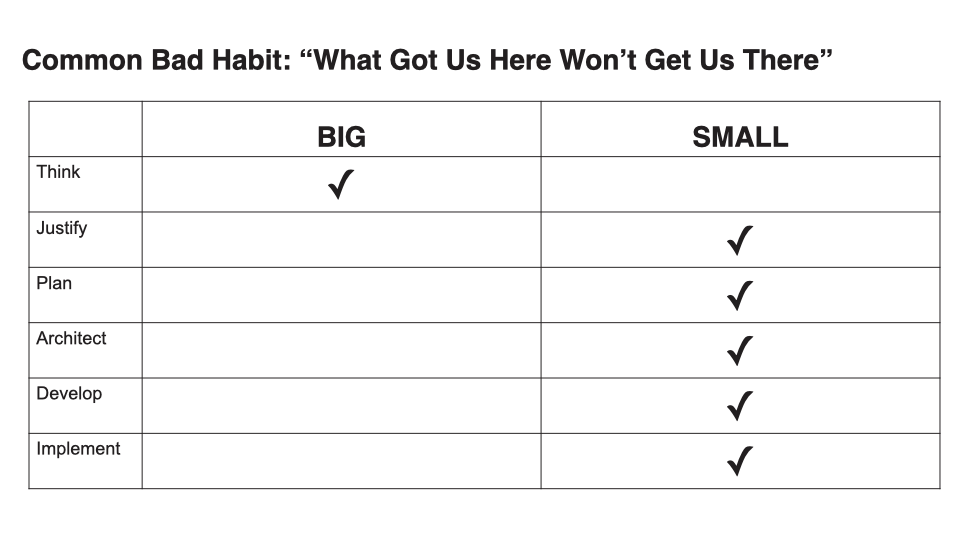
This pattern is dominated by the fight for Annual Budget or Annual Operating Plan (AOP) investments by racking and stacking one unit’s requested projects against another based on the expected ROI for each project investment. IT development teams (estimating projects that might or might not happen) and business and IT leadership teams (debating, trading, and deciding) often spend months of their time building and re-building “the Plan”. This adds very little value and, in fact, perpetuates two big problems. First of all, in most cases, they’ve never “seen the money” (meaning actually realized and measured the expected ROI of the projects). Second, the resulting technology has unintentionally created, over decades, a “patchwork quilt” of applications and technology connected together with a “hairball” (or point-to-point) integration approach (see Part 5 of this series).

To combat the exhausting and disastrous effects of the small-to-medium aperture approach to IT investments, many companies turned to the large-to-gigantic, multi-year ERP-like bets.
Common Bad Habit #2: Everything is “BIG Aperture”
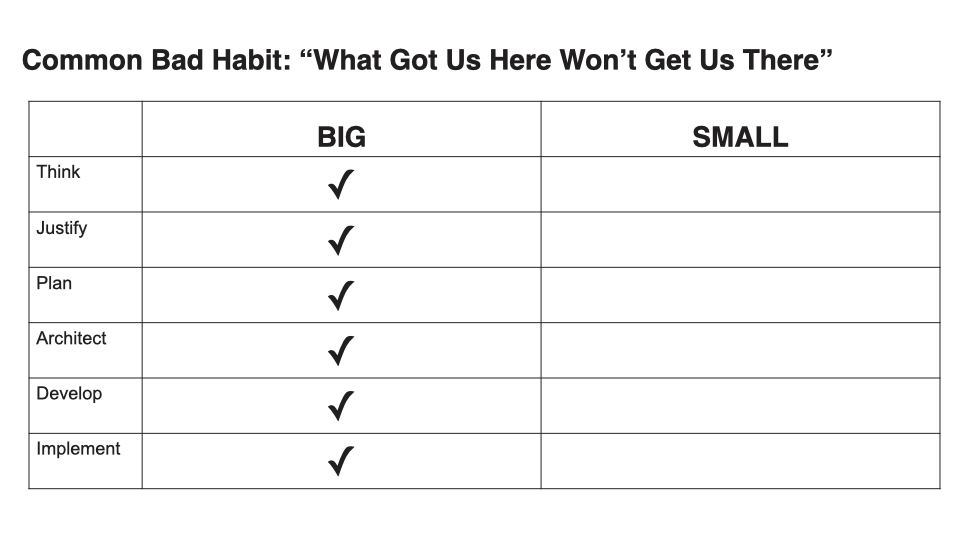
Those approaches, for the most part, have historically been disappointing, at best. This is where IT has “gone away” for years to implement the “perfect” solution by trying to fully replace the legacy base. Unfortunately, this approach has rarely delivered on the promise and has often turned into big write-offs.
Proven Practice: Think, Plan, Justify, Architect BIG | Develop, Implement SMALL
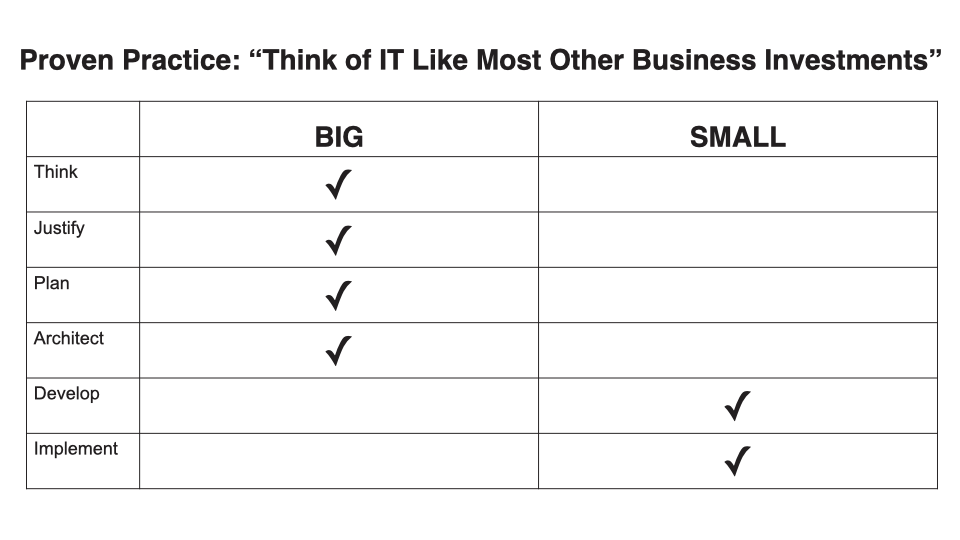
This approach is similar to the way we think about most other major business investments. Here are some examples I’ve used from companies where I was the CIO.
At Frito-Lay, major investment in manufacturing plants was always a multi-year program that had a multi-year plan but was implemented in phases. The plan and implementation included retiring or modernizing several older, less productive facilities – in addition to building new plants. The program created incremental value – measured in additional volume, higher quality, and lower cost – along the way. In fact, most of the time we had a strategic theme like “double in place” (double capacity while flattening the cost curve) or “operation offset” (making up for inflation). These themes and big key metrics gave the program a trackable, visible “brand” and kept the long-term focus and commitment of the Board, the executive committee, and the workforce. At BNSF Railway it was the investment in track upgrades. This worked well with all constituents in the business since track actually physically wears down and becomes measurably less productive over time. For example, new track may enable a train to run at 60 MPH, whereas, that same train may have to slow down to 30 MPH after several years of track wear. At Delta Air Lines, using a similar thought process, the analogy we used was fleet replacement and modernization.
As CIO for those companies, I worked with the CEO and the CFO, in tight partnership, to create the same logic and approach for major investments. Here are some examples from those companies that show how the pattern extends to IT investments if you think about them the right way.
In Practice: The Frito-Lay (1980s)
At Frito-Lay, in the late 1970s and early 1980s, Wal*Mart insisted on “Everyday Low Price”. This triggered all other retailers to begin to leverage their purchasing power to try to keep up. But Kroger had less power than Wal*Mart but more power than 7-Eleven, and 7-Eleven had more power than a small player like a family-owned bar & grill. It was clear that we needed “the ABILITY to price and promote at the customer and store level”. Since our 10,000 route salespeople called on multiple customers in a day, we also needed “the ABILITY to customize products, pricing, and promotions for each individual route”. And, we needed “the ABILITY to make sure that each route was profitable”. From a technology perspective, we needed “the ABILITY to allow the salespeople to be very mobile during the day”, and we needed to be able to deliver the above CAPABILITIES, and about 100 others, to the device every day. It was clear that this was more than a series of disconnected projects proposed by various departments. This was going to be a full transformation from our first 50 years in business.
Getting to the vision not only required 10,000 handheld (mobile) devices, but also, it required the integration of manufacturing, distribution, purchasing, accounting, and other sales CAPABILITIES that, for the most part, already existed in functional systems. The “knitting” together (think “fabric” as mentioned above) of CROSS-FUNCTIONAL CAPABILITIES became our architectural picture (see the “puzzle box top” from Part 4 of this series). Our plan was not about individual projects coming from departments. The plan had to be about a sustained progression of upgrading/enhancing (existing as available), creating (new as needed), and integrating (all) the necessary CAPABILITIES.
We recognized the similarities between IT and other major investments, and we patterned our approach accordingly. The business case was built on big themes, like “Route Sales Automation and Enablement”, “Product Innovation & Line Item Proliferation”, “Precision, Tailored Pricing and Promotions”, “Double In Place – Manufacturing Leverage” and highly visible and critical metrics, such as a 1% reduction in selling expense – whether achieved through growth, efficiency, or both. We had a multi-year program that had a multi-year plan but was implemented in smaller phases. Each phase created measurable, trackable value – just like every other major business investment.
Here are two quick videos that show Leo Kiely, COO of Frito-Lay at the time, and I talking about the vision and the big strategic and competitive mandates that were the driving force behind this BIG thinking, justifying, planning, and architecting of our future.
As we worked through the details and elaboration of what that really meant, it was critical that we clearly articulated the linkage of Business Outcomes, Strategic Themes, and “ABILITIES to…” statements. The “ABILITIES to” became the deliverable for IT investment that would, in turn, enable the business to compete and deliver the business and financial outcomes required.
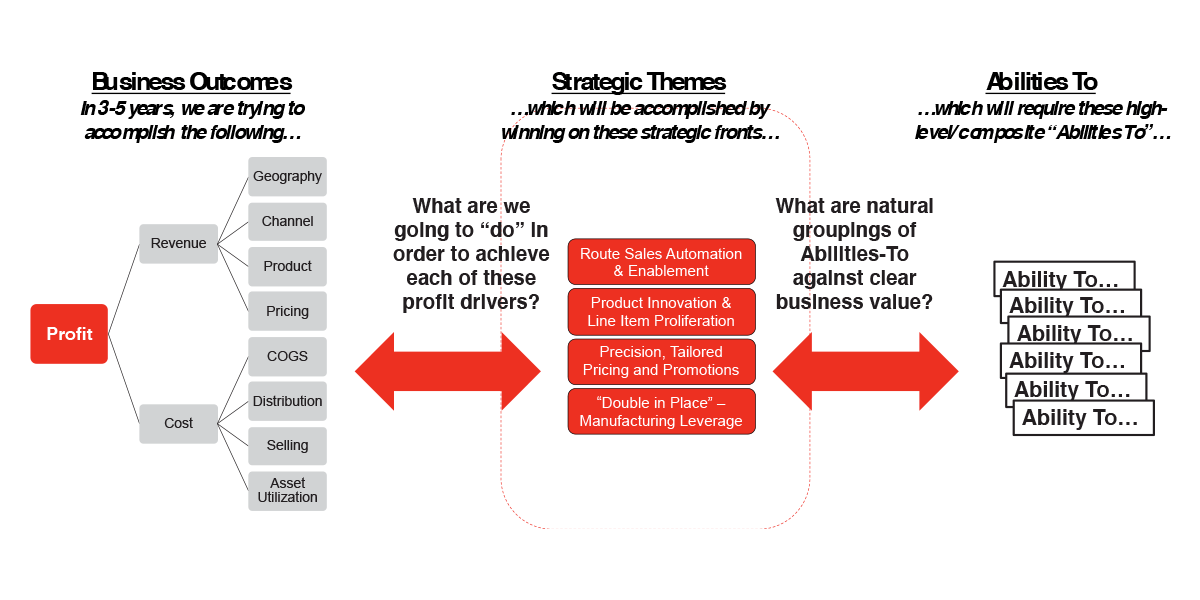
In Practice: Delta Air Lines (1990s-2000s)
When I got to Delta Air Lines in 1997, they desperately needed to improve the Customer and Employee experiences and also systemically improve the Cost per Available Seat Mile (CASM).
To support those major business themes, each function had “racked up” dozens of proposed projects. Each function head was an advocate for their projects being critical to achieve the company’s overall business outcomes. Unfortunately, their passion was based on their local interpretations. As a result, there were literally hundreds of functional projects that had been defined and scoped, one at a time. Each of them had thoughtful business cases, but there was no cohesiveness across functional or business unit lines.
I began working with the CEO, the CFO, and the head of Strategy to think about how this all should fit together. Here’s Leo Mullin, CEO of Delta at the time, talking about our strategic mandate on Safety, Quality, On-Time Performance, Cost, and Customer Service. Notice how, in only one minute, Leo tightly relates these cross-cutting themes and outcomes to each other into one big idea around the Airport Experience and Gate & Boarding.
So, we got to work by rationalizing the functional projects into larger “Portfolios” and then breaking them down into English-level conversations and diagrams. For example, our dialogue changed to be more like, “we need the ABILITY to have the baggage stay with the customer if they miss their connection.” Sentences like that could then lead into further drilldowns into a long list of “ABILITIES to” statements that touched many functions. “Customer Delight” is not a one-department initiative, it takes multiple functions to make that happen. The same thing was true for improving the efficiency of the operation.
This exercise took about 90 days and set the overall business case for the next few years – including the cost, the value, and the optimal sequencing and pacing. One real benefit that came out of this approach was that we were able to identify that improvement of the Gate & Boarding was a high-leverage opportunity to focus on one significant business process and accomplish many of our cross-functional business goals. Gate & Boarding, a critical process on the day of flight, was at the intersection of the customer experience, the employee experience, and cost leverage for the operation. It also enabled us to build much of the data and integration platform.
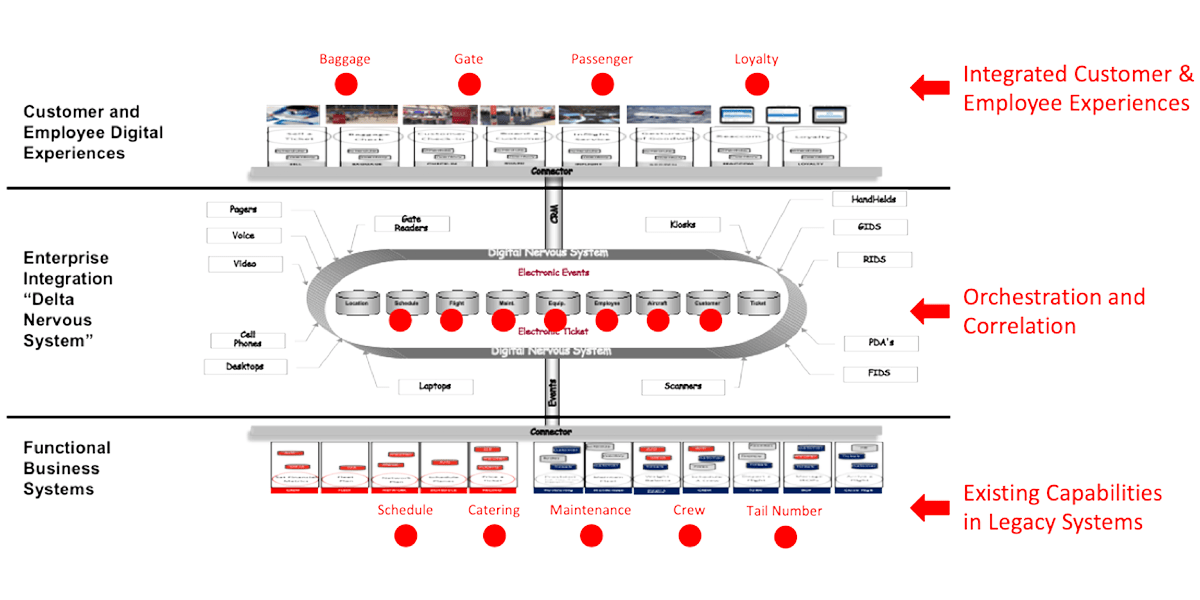
If we had an efficient gate that was fully automated with a plane, crew, catering, fuel, and baggage ready to go, we could quickly and efficiently board the passengers and depart on-time. This would reduce our costs on the ground and reduce customer delay and frustration. Every minute of reduced time to “TURN” a flight was value that could be created and tracked. Operations was willing to sign up for the value creation if we were willing to build and invest in the capabilities required. The same was true for the revenue impact we could have by delighting (rather than frustrating) customers. We had a “Deal” – “you give me this and I’ll give you that” – in a clear and trackable framework, just like every other investment that the CFO, CEO, and Boards are routinely asked to make. We would’ve never gotten there in a project-by-project, year-by-year Annual Operating Plan (AOP) framework.
Even today, Delta continues to be innovative and competitive and able to constantly change the technology to enable the always-changing business. They have benefitted now for decades from the financial and investment approach that allowed for building a technical architecture that was “built to last because it was designed for change”.
The “Highway” Analogy
The infrastructure, the integration of systems, and the real-time movement of data that has always been and is now, more than ever, required for cross-functional, strategic, and real-time sense-and-respond systems (using a “digital twin” of the physical operation) could be thought of as building a “Digital Highway” system. The level of planning and investment in this “Digital Highway” system is analogous to the scale of the Interstate Highway System (infrastructure) that played a major role in connecting and integrating the US during the 20th century and into the present day.
That highway system took multiple years and required a thoughtful plan, a patient commitment, a sustained investment, and a well-articulated blueprint. Once approved it was built in sections and opened for use while the next section was started and built. It was built not just from east to west but also from west to east – and even in the central part of the country. There was, based on the plan and the blueprint and the sustained commitment, full confidence that it would seamlessly come together into a connected interstate system over time. Also, since the system was conceived, justified, architected, and planned “big”, the cities and towns were able to make their own local, independent plans and investments with clarity and forethought. The ones that would be along the Interstate route grew with the anticipated knowledge of when the road and on/off ramps would be available to connect them with the rest of the country. Others also knew if the Interstate was not going to connect their town and could, accordingly, plan to build longer feeder roads to connect to the main system in the right places.
It doesn’t take a big leap to think about our IT systems in a similar way. We need a thoughtful plan, a patient commitment, a sustained investment, and a well-articulated blueprint to guide a coordinated effort over multiple years. If we have that, we can then break down the work into smaller pieces to develop, build, implement incrementally and with the proper level of autonomy to allow for continuous progress and delivery of value.
The Approach for HOW to Invest in IT for Business & Technical Agility
This approach to IT investments and value creation starts with creating a high-level “Story” that aligns everyone to a range of business, financial, and technical outcomes and a case for change. This “Story” also includes chunking (big campaigns of investment sustained over time) and sequencing (in broad timeframes of First, Next, and Later) over a 3-5 year horizon. Once that’s generally agreed to, then the focus should zoom in on a 2-3 year, more granular, “Deal” with true sequencing, investment estimation, and coordinated pacing of IT delivery and business changes across functions for the big initiatives (as described in the Delta Air Lines example above). Once that “Deal” is struck, the next step is to build a rolling 12-18 month detailed execution “Plan” that sets up funding releases in 6-12 month increments with deliverable business value in 60-90 day value packages.
This approach was generally adopted in 25-30 Feld Group clients including BNSF Railway, Delta Air Lines, Southwest Airlines, Wellpoint, First Data Corp., and others. Over time, the principles have proven durable, but the techniques and language for thinking, justifying, planning, and architecting BIG and developing and implementing SMALL have matured and professionalized. A number of leading companies we work with today in The Feld Group Institute, like FedEx, have fully adopted a capability-based multi-year planning and investment approach for their transformation journey.
In Practice: FedEx (Current)
FedEx, which is experiencing explosive growth due to the acceleration of e-commerce over the last several years and in a dramatic way since COVID hit, continues to plan, justify, and architect “big” and implement new capabilities, tied to value streams, in “small” 10-week increments. This is owed to a real partnership between the CIO, CEO, and COO. That has been nurtured over the years and is paying huge benefits now and into the future. FedEx has worked hard to change the game – for Business and Technical Agility – by changing the business and IT investment and economic model conversation. It wasn’t easy, but they’ve broken through and are eliminating the gap, or the “daylight”, that existed between business and IT. They are now thinking about investments in technology like they have always thought about investments in fleet and facilities, rather than as a general administrative overhead function.
HOW We Invest in IT is the Make-or-Break Factor in the Digital Era
Today, 40 years later, this is exactly how “digital native” companies like Uber, Apple, and Amazon approach their business and technology architecture and their sustained investment in their “digital fabric” – because they know that technology is at the heart of the business. Most “legacy” companies we see today are still practicing the “Common Bad Habits” described above, but many more progressive CEO/CFO/CIO teams are beginning to think in this new – but actually old, tried, and true – way of thinking about IT investments.
The reason this approach has become even more important in the last 20 years is that the most value, for strategy and competitiveness, is created when multiple capabilities, from multiple functions or business units, are combined and integrated into new workflows. We have to think, plan, justify, and architect with this bigger perspective in order to drive a Customer or Supply Chain or New Product or Pricing/Promotion cross-functional value.
Interestingly enough, a majority of these functional capabilities already exist in the legacy systems we have. But they need to be cleaned up, made available, consumed, and integrated into these kinds of cross-functional solutions. This “unlock” of existing capabilities and the orchestration of innovative solutions is the only reasonable, affordable, and practical pathway in Digital Transformation. And, it’s proven over decades.
Author: Charlie Feld, Founder and CEO, The Feld Group Institute
Further Learning
If you are interested in learning more about this topic, additional resources can be found on our site, including Leading The Acceleration Of Digital Transformation Part 1: WHY The Time Is Now, Leading The Acceleration Of Digital Transformation Part 2: The WHAT Is Business Agility, Leading the Acceleration of Digital Transformation Part 3: Changing HOW the Technology is Built, Leading the Acceleration of Digital Transformation Part 4: HOW We Build IT to Last by Designing for Change, and Leading the Acceleration of Digital Transformation Part 5: HOW Accounting Practices Shaped Our Legacy IT “Hairball”


